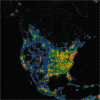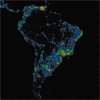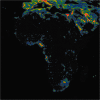The new world atlas of artificial night sky brightness
- PMID: 27386582
- PMCID: PMC4928945
- DOI: 10.1126/sciadv.1600377
The new world atlas of artificial night sky brightness
Abstract
Artificial lights raise night sky luminance, creating the most visible effect of light pollution-artificial skyglow. Despite the increasing interest among scientists in fields such as ecology, astronomy, health care, and land-use planning, light pollution lacks a current quantification of its magnitude on a global scale. To overcome this, we present the world atlas of artificial sky luminance, computed with our light pollution propagation software using new high-resolution satellite data and new precision sky brightness measurements. This atlas shows that more than 80% of the world and more than 99% of the U.S. and European populations live under light-polluted skies. The Milky Way is hidden from more than one-third of humanity, including 60% of Europeans and nearly 80% of North Americans. Moreover, 23% of the world's land surfaces between 75°N and 60°S, 88% of Europe, and almost half of the United States experience light-polluted nights.
Keywords: astronomy; environmental protection; light pollution.
Figures



















References
-
- Cinzano P., Falchi F., Elvidge C. D., Baugh K. E., The artificial night sky brightness mapped from DMSP satellite Operational Linescan System measurements. Mon. Not. R. Astron. Soc. 318, 641–657 (2000).
-
- Garstang R. H., Night-sky brightness at observatories and sites. Publ. Astron. Soc. Pac. 101, 306–329 (1989).
-
- Smith M., Time to turn off the lights. Nature 457, 27 (2009). - PubMed
-
- Cinzano P., Falchi F., Elvidge C. D., The first World Atlas of the artificial night sky brightness. Mon. Not. R. Astron. Soc. 328, 689–707 (2001).
Publication types
MeSH terms
LinkOut - more resources
Full Text Sources
Other Literature Sources

